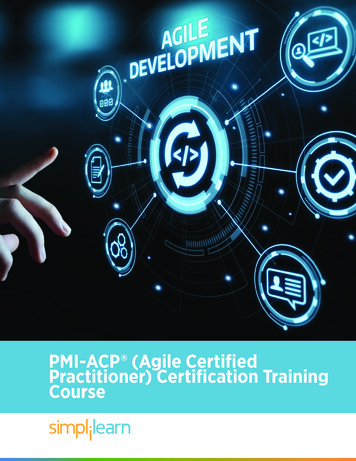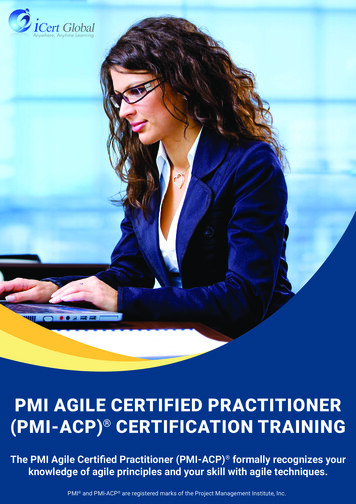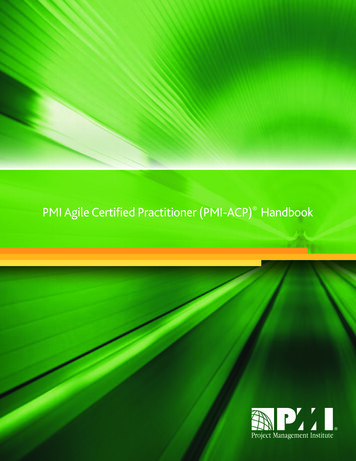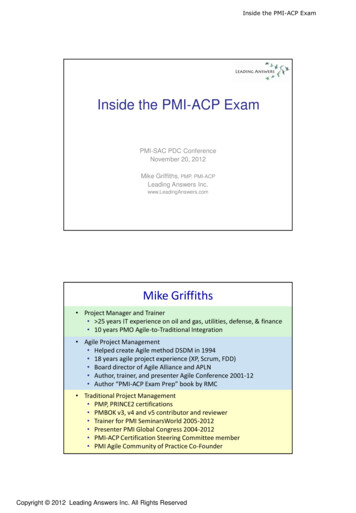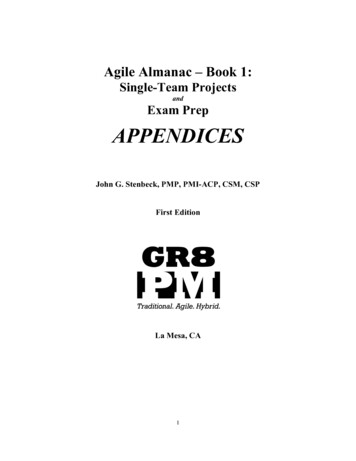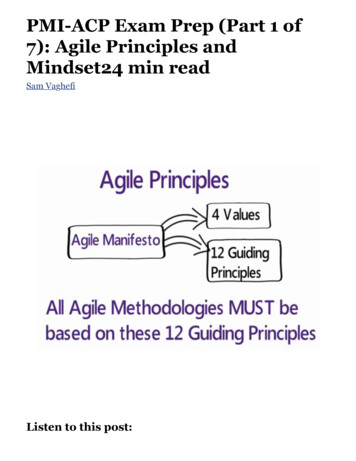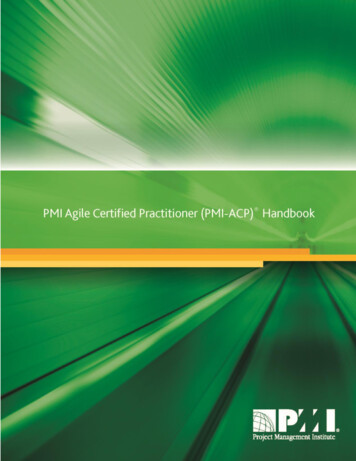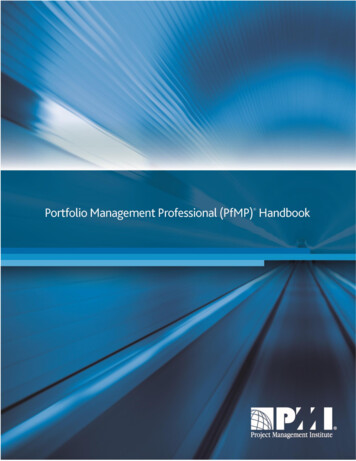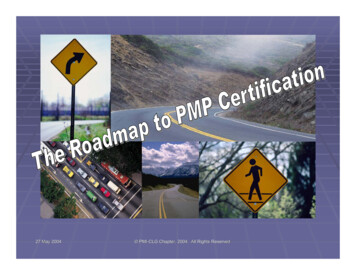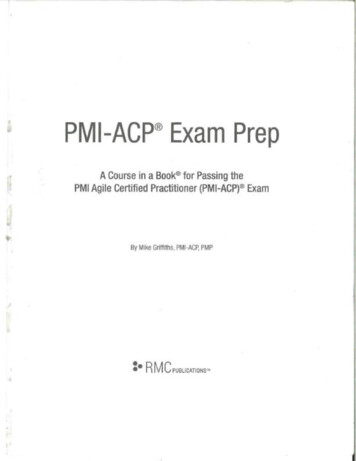
Transcription
LPMI-ACP Exam PrepA Course in a Book for Passing thePMI Agile Certified Practitioner (PMI-ACP) Exami. By Mike Griffiths, PMI-ACP, PMPIrI:«RMCPUBLICATIONS
Copyright 2015 RMC Publications, Inc. All rights reserved. Except as permitted under the United States Copyright Act of 1976, no part of thispublication may be reproduced or distributed in any form or by any means, or stored in a database orretrieval system, without the prior written permission of the publisher.PMI-ACP’ Exam PrepPrinted in theUnited States of AmericaThird PrintingISBN: 978-1-932735-98-7Library of Congress Control Number: 2015948973Figures 1.13, 2.16, 2.23, 2.24, 2.25, 2.26, 3.12, 3.13, 4.9, 4.14, 5.19, 5.20, 5.24, 5.26, Umbrella Man, ShovelMan, Vision Man, and Cart Man were adapted from images originally published by Leading Answers,Inc.,original image copyright 2012 Leading Answers, Inc. Images reproduced and adapted with permissionfrom Leading Answers, Inc., www.leadinganswers.com.Agile FASTrack is a trademark of RMC Project Management, Inc.PMI, PMI-ACP, PMP, PMBOK, and SeminarsWorld are registered marks of the Project ManagementInstitute, Inc.This publication uses the following terms trademarked by the Project Management Institute, Inc.: ProjectManagement Institute (PMI) , PMI Agile Certified Practitioner (PMI-ACP) , Project ManagementProfessional (PMP) , and A Guide to the ProjectManagement Body of Knowledge (PMBOK* Guide).PRINCE2 is a registered trademark of AXELOS Limited.RMCPUBLICATIONS Phone: 952.846.4484Fax: 952.846.4844Email: info(3)rmcls.comWeb: www.rmcls.com
r»DedicationTo Jake and Samantha.Jake, your hard work andperseverance are a true inspiration. WheneverIfeel disheartenedabout a taskIthink of how hard you try, howfar you have come, and where you might go.Never stop trying, never stop working; you can do great things.Sam, thank youfor supporting me. You insulate the worldfrom my random ideas and crazyplans. Thanksfor being my bestfriend all these years.
-
Table of ContentsAuthor’s AcknowledgementsPublishers AcknowledgementsAbout the AuthorAbout RMC Learning SolutionsxixiiixvxviiIntroduction: About the PMI-ACP Exam1About the ExamQualifying to Take the Exam2228Exam ContentExam AssumptionsThis Book’s ApproachHow PMI Exams Are CreatedReference Books and Exam TopicsWatch Out for Free Online Quizzes!How This Book Is OrganizedChapters and DomainsDomain SummariesExam Tips and Background InformationExercisesReview QuizzesOnline Extras and RMC s Exam Prep SystemOther Study Resources for the PMI-ACP ExamHow to Study for the PMI-ACP ExamPlan A: Using This Book with the PMI-ACP* Exam Prep SystemPlan B: Using This Book as a Stand-Alone Study ResourceHow to Use This Book in a Study GroupChapter 1: Agile Principles and MindsetDomainISummaryWhy Use Agile?Knowledge Work Projects Are DifferentDefined versus Empirical ProcessesThe Agile MindsetPersonal, Team, and Organizational AgilityThe Agile TriangleThe Agile ManifestoThe Four ValuesThe Twelve PrinciplesAgile MethodologiesScrumExtreme Programming (XP)Lean Product DevelopmentKanban 2015 RMC Publications, Inc 952.846.4484 info(a)rmcls.com 222224262728314041485459ViiSW
Table of ContentsFeature-Driven Development (FDD)Dynamic Systems Development Method (DSDM)62636365CrystalAgile Process OverviewAgile LeadershipManagement versus LeadershipServant LeadershipTwelve Principles for Leading Agile ProjectsAgile Leadership PracticesLeadership TasksChapter Review666668707173Chapter 2: Value-Driven Delivery83DomainII SummaryWhat Is Value-Driven Delivery?Deliver Value Early (Eat Your Dessert First!)Minimize Waste838485858675Assessing ValueFinancial Assessment MetricsEarned Value ManagementAgile Project AccountingKey Performance Indicators (KPIs)Managing RiskRegulatory CompliancePrioritizing ValueCustomer-Valued PrioritizationPrioritization SchemesRelative al Viable Product (MVP)Agile ToolingLow-Tech, High-Touch ToolsTask/KanbanBoardsWork in Progress 511812012312312412S126126127128128130139WIP LimitsCumulative Flow Diagrams (CFDs)Bottlenecks and the Theory of ConstraintsAgile ContractingAgile Constraints and ContractsDSDM ContractMoney for Nothing and Change for FreeGraduated Fixed-Price ContractFixed-Price Work PackagesCustomized ContractsVerifying and Validating ValueFrequent Verification andValidationTesting and Verification in Software DevelopmentChapter Reviewvi. 201S RMC Publications, Inc 9S2.846.4484 info@rmcls.ci www.rmcls.com
Table of ContentsIChapter 3: Stakeholder EngagementDomainIII SummaryTaking Care of StakeholdersStakeholder Stewardship versus Stakeholder ManagementEducating Stakeholders about AgileKeeping Stakeholders EngagedWhy the Big Focus on Stakeholders?Principles of Stakeholder EngagementEstablishing a Shared VisionAgile CharteringDefinition of “Done”Agile ModelingWireframesPersonasCommunicating with StakeholdersFace-to-Face CommunicationTwo-Way CommunicationKnowledge SharingInformation RadiatorsSocial MediaWorking CollaborativelyWorkshopsBrainstormingCollaboration GamesUsing Critical Interpersonal SkillsEmotional IntelligenceActive ListeningFacilitationNegotiationConflict ResolutionParticipatory Decision MakingChapter ReviewChapter 4: Team PerformanceDomain IV SummaryWhy People Over Processes?Agile Team RolesBuildingAgile TeamsBenefits of Generalizing SpecialistsCharacteristics of High-Performing TeamsModels of Team DevelopmentAdaptive LeadershipTeamMotivationTraining, Coaching, and MentoringCreating Collaborative Team SpacesCo-Located TeamsOsmotic Communication 2015 RMC Publications, Inc 952.846.4484 info@rmcls.com 3vii
Table of ContentsGlobal, Cultural, and Team DiversityDistributed TeamsTracking Team PerformanceBurn ChartsVelocityChapter ReviewChapter 5: Adaptive PlanningDomain V SummaryAgile Planning ConceptsAdaptive PlanningAgile versus Non-Agile PlanningPrinciples of Agile PlanningAgile DiscoveryProgressive ElaborationValue-Based AnalysisValue-Based DecompositionTimeboxingEstimate RangesIdeal TimeTools for Sizing and EstimatingSizing, Estimating, and PlanningDecomposing RequirementsUser StoriesUser Story Backlog (Product Backlog)Refining (Grooming) the BacklogRelative Sizing and Story PointsAffinity EstimatingT-Shirt SizingStory MapsProduct RoadmapWideband DelphiPlanning PokerRelease and Iteration PlanningTypes of IterationsSpikesHigh-Level Planning (Visioning)Release PlanningIteration PlanningDaily Stand-UpsChapter ReviewChapter 6: Problem Detection and ResolutionDomain VI SummaryUnderstanding ProblemsHow Problems Impact.a ProjectThe Cost of Changeviii 2015 RMC Publications, Inc 9S2.846.4484 info(2 rmds.com 286287289291291293296297303309313321321322322324
Table of ContentsTechnicalDebtCreate a Safe and Open EnvironmentFailure ModesSuccess ModesSuccess StrategiesDetecting ProblemsLead Time and Cycle TimeDefectsVariance AnalysisTrend AnalysisControl LimitsManaging Threats andIssuesRisk-AdjustedBacklogRisk SeverityRisk Bumdown GraphsSolving ProblemsProblem Solving as Continuous ImprovementEngage the TeamSome Problems Can’t Be SolvedChapter ReviewChapter 7: Continuous ImprovementDomain VII SummaryKaizenMultiple Levels of ImprovementContinuous Improvement—ProcessProcess TailoringSystems ThinkingProcess AnalysisValue Stream MappingProject Pre-MortemsContinuous Improvement —ProductReviewsProduct Feedback Loops and Learning CyclesFeedback MethodsApproved IterationsContinuous Improvement—PeopleRetrospectivesTeam Self-AssessmentsPMI’s Code of Ethics and Professional ConductChapter tesIndex 2015 RMC Publications, Inc 952.846.4484 info(5 rmcls.com www.rmcls.comix
*
Author’s AcknowledgmentsIwould like to recognize David Anderson for encouraging me to start blogging about agile projectmanagement in 2005 when we were working on the APLN board together. Thanks, it has opened manydoors for me.Iam grateful, too, to Doug DeCarlo, who got me started writing articles for ProjectManagement.com andput me in touch with RMC and the discussions for this book.The first edition of this book would not have happened without the help, support, and encouragementof my first editor, Laurie Diethelm. She intuitively understood agile and servant leadership, all the thingsIwas trying to explain in the book—and she modeled them perfectly. She transformed my disjointedramblings into a consistent voice and steered my rants toward useful exam preparation advice. However,the biggest thing she did was to provide consistent encouragement and a rational voice when competingdemands for my time threatened the timeline.Rose Brandt did a great job fact-checking the first edition of the book and then acting as the editor ofthe second edition.1am grateful for her patience and professionalism. We fixed up and improved manyaspects of the second edition, in most part due to Rose’s hardwork.Jason Craft and Whitney Thulin transformed my scribbles into comprehensible diagrams, and this book’sconsistent appearance is in large part due to their hard work.Thanks are due to the reviewers of the first edition, too, who provided valuable feedback on sometimesincomplete chapters, making adaptation and improvement possible.Finally, thanks to the indexers, typesetters, and publishers whose roles and work often go unrecognized,but without whom, quite literally, there would be no book.To these people and thoseIhave not directly mentioned here, but who still helped, thank you. My namemay be on the cover, but your work and influence are in these pages, andIam grateful.—Mike Griffiths 2015 RMC Publications, Inc 952.846.4484 info(o rmcls.com www.rmcls.comxi
*-
Publisher’s AcknowledgmentsRMC Learning Solutions (formerly RMC Project Management) would like to thank thefollowingpeoplefortheir invaluable contributions to this book:EditingProduction/Layout GraphicsRose BrandtDeborah KaufmanWhitney TimlinJason CraftReviewers (First Edition)Dr. Alistair CockburnCo-author of the Manifestofor Agile Software Development, co-founder of the International ConsortiumforAgile, PMI-ACP Steering Committee MemberDennis StevensPMI-ACP Steering Committee Member, PMIAgile Community ofPractice Council LeaderEnterprise Agility Coach, LeadingAgileMichele Sliger, PMI-ACP, PMPPMI-ACP Steering Committee Member, co-author of The Software Project Manager s Bridge to AgilitySliger ConsultingTheofanis C. Giotis, PMI-ACP, MSc, Ph.D. C., PMP, MCT, PRINCE212PM ConsultingUrsula Kusay, PMI-ACP, PMPCSC DeutschlandAkademie GmbHAnton JosefMuller, PMP, CBAPCSC Deutschland Akademie GmbHAndreas Buzzi, PMI-ACP, PMP, CSM, and OpenGroup certified Architect & IT SpecialistCarlos Sanchez-Sicilia, PMP, CBAP, CGEIT, CRISCJeffrey S. Nielsen, PMI-ACP, CSM, PgMP, PMP,PMI-RMP, MSCISMargo Kirwin, PMI-ACP, PMI-PBA, PMP, CPLPAdditional Contributors (First Edition)Eric Rudolf, CSM, CSPOBarbara A. Carkenord, PMI-ACP, PMP, PMI-PBA, CBAP 2015 RMC Publications, Inc 952.846.4484 info( rmcls.com www.rmcls.comxiii
.
About the AuthorMike Griffiths is a world-renowned project manager, trainer, consultant, and writer,holding multiple project management and agile-related certifications. Mike was on theoriginal PMI-ACP Steering Committee, which defined the agile-related knowledge, skills,tools, and techniques to be tested on the PMI-ACP exam. He helped create A Guide to theProjectManagement Body ofKnowledge (PMBOK* Guide) Fifth Edition, as well as theSoftware Extension to the PMBOK* Guide.—Mike frequently presents at PMI Global Congress conferences, and teaches a two-day AgileProject Management course for the Project Management Institute (PMI) as part of their travelingSeminarsWorld program. He also helped start the PMI Agile Community of Practice, which is now thelargest PMI community in existence.Mike helped create the agile method DSDM (Dynamic Systems Development Method) and has beenusing agile methods including FDD, Scrum, and XP for the last 20 years. Mike also served on the Boardof Directors for the Agile Affiance and the Agile Project Leadership Network (APLN). In addition toextensive agile methods experience, Mike is very active in traditional project management, holding boththe PMP* and PRINCE2 certifications. 2015 RMC Publications, Inc 9S2.846.4484 info(S)rmcls.com www.rmds.comXV
.
About RMC Learning SolutionsRMC Learning Solutions (formerly RMC Project Management) develops and trains project managers,business analysts, and agile practitioners byproviding the hard skills, soft skills, andbusiness knowledgenecessary for them to succeed in their careers. Since 1991, RMC has helped more than 750,000 individuals —as well as executives across the Fortune 500 and in government agencies—accomplish the following:»»»»»Develop practical knowledge immediately applicable to their careers.Deliver organizational results using proven techniques andbest practices.Attract, develop, and retain top talent to work on key initiatives.Consistently bring projects in on time and under budget.Increase the adoption of training through coaching and mentoring.Today, RMC delivers a wide range of project management, business analysis, and agile training in multiplelearning formats including traditional classroom training, live online training, self-directed e-learning,books, and software. The company also continues to reinforce its training via ongoing coaching,mentoring, and organizational transformation services.What Makes RMC UniqueIn addition to the above, RMC Learning Solutions separates itself from what has become a very crowdedtraining marketplace by offering the following value-added advantages:» Proven techniques. RMC provides individuals and teams with the opportunity to learn and use highlyeffective project management, business analysis, and agile practices that can be applied immediatelyon their current projects. We listen to students and clients, and integrate their ideas and perspectives toenrich each and every learning experience.» Outcome-based learning. All RMC instruction and content focuses on a continuous cycle oflearning. We plan your learning, set goals, and teach—then measure progress toward goals and adjustaccordingly. RMC incorporates real-time feedback into all of its programs wherever possible, and isalways monitoring for additional learning opportunities.» Professional instructors. RMC actively recruits high-performing instructors who are championsof — and experts in—their respective disciplines. AllRMC instructors have a deep conceptualunderstanding of their practice area, and use a variety of strategies designed to help students understandAND apply what they are learning in the real world.» An international reach. Through our extensive international distributor and training providernetwork, RMC is able to offer its training in 18 languages and more than 60 regions across the globe.This ensures all RMC students receive the same quality of training and delivery, and the same trainingexperience—no matter where they maybe located.» Multiple ways to learn. In addition to traditional instructor-led training, RMC offers a variety oflearning modes to meet both individualand corporate training needs. From live online classes and selfdirected e-learning courses to books, software, and templates, RMC offers students the opportunity tolearn in multiple formats and at multiple pricepoints. 2015 RMC Publications, Inc 9S2.846.4484 mfo( rmcls. www.rmcls.comxvii
We Need You to Help Us Stop Copyright InfringementAs the publisher of some of the best-selling exam prep books on the market, RMC is also, unfortunately,one of the most illegally copied. It is true that many people use our materials legally and with ourpermission to teach exam preparation. However, from time to time, we are made aware of others who copyour exam questions, tips, and other content illegally and use them for their own financial gain.If you recognize any ofRMC’s proprietary content being used in other exam prep materials or courses,please notify us at copyright(5)rmds.com immediately. We will do the investigation. Please also contactus at the e-mail address above for clarification on how to use our materials in your class or study groupwithout violating any laws.Contact UsWe love to hear your feedback. Is there anythingin thisbook that you wish was expanded? Is thereanything we focus on too much, or is there anything not covered that you think shouldbe here? We wouldlove to hear from you. Send us an e-mail at agileprep(3)rmcls.com.Free Updates and ExtrasPurchasing this book gives you access to valuable supplemental study tools for the PMI-ACP exam atshop.rmcls.com/agileprep. Be sure to take advantage of those resources, which include a practice quiz thatcan help you determine if you are ready to take the exam. Also, be sure to check back from time to time,since we will continue to add more resources to that site. (You will need your copy of thisbook the firsttime you access that website.)xviii 2015 RMC Publications, Inc 952.846,4484 info nncls.com vww.nncls.com
INTRODUCTIONAbout the PMI-ACP ExamWelcome to the second edition of PMI-ACP* Exam Prep. Since the first edition of this book, the PMI-ACPexam has gone from being a foray into new agile territory for PMI, to their fastest-growing credential ever.This credentialhas been growing even faster than the PMP credential, and it is now set to be a significantqualification in the domain of project delivery—not just for leaders and managers, but also for agilepractitioners and team members.The PMI Agile Certified Practitioner is now an established agile certification sought by professionals andhiring managers alike. In a marketplace that was filled with a confusing mix of easy-to-obtain credentials,the PMI-ACP has emerged as a meaningful measure of agile experience and knowledge. PMI has achievedthis by requiring education, relevant experience, and training— as well as by applying the rigor of ISO/IEC17024 requirements to ensure good question design and rigorous examination management. So there are noshortcuts, easy options, or free passes to earning this certification.If you are just starting on your path towardobtaining the PMI-ACP, this might sound daunting—but it’s also what makes the credential so valuable.Everyone knows you have to earn it, and that it means you have verified skills. Fortunately, thebook you areholding is thebest resource you can find to help you pass the exam and obtain your PMI-ACP certification.Since the PMI-ACP exam was first offered in 2011, the agile techniques that it tests havebeen validatedby surveying thousands of practitioners who use agile methods. PMI wanted to make sure the techniquesincluded in the exam content outline were in fact common practice, and used in proportions that matchedthe weightings of the exam questions. So in 2014 they conducted a role delineation study.This survey ended up strongly validating the exam content. However, it also highlighted the importanceof having an agile mindset (being agile) over merely using agile practices (doing agile). To reflect this,PMI created a new domain called “Agile Principles and Mindset.” The material covered in this domain isn’tnew—the exam coverage has not expanded. Instead, the topics that were previously covered in an “AgileFramework” category outside of the exam domains have now been folded into their own domain.Since the first publication of this bookIhave been fortunate to receive hundreds of letters of thanks andfeedback. The book is consistently rated as the best exam preparation resource available for the PMI-ACPexam, and for many people this book is the only resource they use to prepare for, and pass, the exam. Thiscommunity of successful readers has provided many thoughtful suggestions for improvements to thebook. Their suggestions for more coverage of lean and Kanban approaches and a host of other ideas havebeen analyzed, researched, and applied to this new version of the book.In short, as the PMI-ACP exam has gained in popularity it has beenrevisited and improved— and sotoo has this book. In the true agile spirit, through use, review, and adaptation we have produced a betterincrement of the product.Welcome to the first step on your journey. The PMI-ACP is an important, valued credential, and you havewhat you need to prepare — so let’s get started! 201S RMC Publications, Inc 9S2.846.4484 info(3 rmds.com www.nncls.com1
PMI-ACP Exam PrepAbout the ExamIn this introduction, we’ll discuss the scope of the PMI-ACP exam at a high level. The exam consistsof 120 questions, and you will have three hours in which to complete it.Just like on a project, whentaking the exam you need to know what is in scope, what is out of scope, and what you need to do to besuccessful. Let’s start by addressing the qualification requirements, the organization of the exam content,and the exam’s key assumptions.Qualifying to Take the ExamPassing the PMI-ACP exam is just one component of achieving your PMI-ACP certification. The othercomponents are education, general project experience, agile project experience, and training. In order toqualify to take the exam, you need to have all of the following:EducationGeneral ProjectExperienceHigh school diploma,associate’s degree, orequivalent2,000 hours (about 12months) of project teamexperience within thelast five yearsAgile ProjectExperienceTraining in AgilePractices1,500 hours (about8 months) of agileproject team or21hoursagile methodologyexperience within thelast three yearsPMI may make changes to aspects of the exam, including the qualificationrequirements, the application process, the passing score, and the breakdownof questions in each domain. For the latest information, please visit www.pmi.org and read your authorization notice carefully. Any differences between whatis listedhere and what is communicated by PMI should he resolved in favor ofPMI’s information.With 1,500 hours of agile experience, you may have already been exposed to many of the concepts that willbe tested on the exam. However, there are several different agile methods (e.g., Scrum, XP, Kanban, etc.),and each one focuses on different concepts and uses different terminology. This means that the terms andideas you encounter on the exam might be different from what you are familiar with from your projects.Also, the exam questions will draw from a range of agile methodologies-—so knowing one methodologyreally well isn’t enough to pass the exam. As you go through this book, make a note of any terms or conceptsthat differ from your real-world experience so you will be prepared when you see them on the exam.Exam ContentAfter reviewing your qualifications for taking the exam, the next step is to find out what you need to know topass the exam. PMI provides an exam content outline (the “PMI Agile Certified Practitioner (PMI-ACP)*Examination Content Outline”) on its website, www.pmi.org.1 This document outlines what you need toknow for the exam, organizingit into seven domains, a set of Tools and Techniques, and a set of Knowledgeand Skills. Let’s explore these components of the exam content inmore detail.2 201S RMC Publications, Inc 952.846.4484 info@rmcls.com www.rmcls.com
Introduction About the PMI-ACP ExamThe Seven DomainsHie exam content outline organizes the material that will be tested by breaking it down into seventhematically related groups, called domains. Here are the key points to understand about these domains:» The domains are provided simply to organize the vast world of agile and show how PMI intends theexam material to be understood and taught. The exam won’t test the domains themselves or how thetopics are grouped by domain. So don’t spend time trying to remember what is covered in whichdomain. The domains are just a study tool; they won’t be tested on the exam.» You can use the domains to identify the strengths and gaps in your agile knowledge. If your agileknowledge is uneven, you might be an expert in certain areas, but still fail the exam. To pass, you needto have a good basic understanding of all seven domains.» You can use the domains to help you allocate your study time, since the questions on the exam areweighted by domain. (This is the only information PMI provides about how different topics areweighted on the exam.) For example, domainIIhas the most weight (20 percent) and domain VII hasthe least weight (9 percent). Now, this doesn’t mean you can skip studying domain VII and still ace theexam with a score of 91 percent. The exam weighting isn’t that straightforward. But it does mean thatyou should spend more time making sure you thoroughly understand the topics in domain II, sincethey will be required to accurately answer many more exam questions than the topics in domain VII.Here are the name and weighting of each domain as defined in the exam content outline:Weighting of Domains for PMI-ACP ExamDomain VII. ContinuousImprovement (ProductPeople),Domain I. Agile Principlesand Mindset, 16%Domain VI. ProblemDetection andResolution, 10%Domain V. AdaptivePlanning, 12%-Domain IV. TeamPerformance, 16%Domain II. Value-DrivenDelivery, 20%Domain III. StakeholderEngagement, 17% 2015 RMC Publications, Inc 952.846.4484 info( rmcls.com www.rmcls.com3
PMI-ACP Exam PrepDomain OverviewsHere’s an overview of what is covered in each domain:I.Agile Principles and Mindset: This domain focuses on the agile mindset, its fundamental valuesand principles, the agile methodologies, and agile leadership.II.Value-Driven Delivery: This domain deals with maximizing business value, includingprioritization, incremental delivery, testing, and validation.III.Stakeholder Engagement: This domain focuses on working with the project stakeholders,including establishing a shared vision, collaboration, communication, and interpersonal skills.IV.Team Performance: This domain focuses on building high-performing teams, including howteams form and develop mastery, team empowerment, collaborative team spaces, and performancetracking.V.Adaptive Planning: This domain deals with sizing, estimating, and planning,including adaptiveplanning, progressive elaboration, value-based analysis and decomposition, and release anditeration planning.VI.Problem Detection and Resolution: This domain deals with the agile practices used to prevent,identify, andresolve threats and issues, including catchingproblems early, tracking defects,managing risk, and engaging the team in solving problems.VII.Continuous Improvement (Product, Process, People): This final domain focuses oncontinuous improvement in the areas of product, process, and people, including process analysisand tailoring, product feedback methods, reviews, and retrospectives.Chapters 1 through 7 of this book are aligned with these seven domains, with each chapter covering thedomain of the equivalent number. At the start of each of these chapters, we provide a summary of the keyinformation for that domain, including:» The weighting of that domain for the exam (including the number of questions)» The key topics in the domain that are most important to know for the exam» A quick summary of the tasks that fall within that domain, as defined in the exam content outlineAs describedin the “How This Book Is Organized” section of this chapter, you can use the domainsummaries to help allocate your study time and check your understanding of the exam concepts. When youfinish reading each chapter, return to the chapter summary and make sure you understand all the key topicsand tasks, based on the material discussed in the chapter.The Agile Toolkit (T&Ts and K&Ss)In addition to the seven domains, the exam content outline also provides two lists of topics that will betested on the exam— tools and techniques (T&Ts) and knowledge and skills (K&Ss).Tools and Techniques (T&Ts) —These are specific practices you should be able to do or use, such asstory maps, active listening, or daily stand-ups. The exam will test your ability to apply these practices,often with brief scenario questions that ask “what should you do” or “what happens next?”4 2015 RMC Publications, Inc 952.846.4484 info(2)rmcls.com wwwr.nncls.com
Introduction About the PMI-ACP ExamKnowledge and Skills (K&Ss) —These are broader areas you shouldknow or understand, such asincremental delivery, problem solving, or prioritization. Every question on the exam will he implicitlybased on one or more of the knowledge and skills on this list. You can think of these topics as theinvisible groundwork or understructure required to answer the exam questions. Also, like the T&Ts,you may encounter some scenario questions that ask about these topics directly.Although the exam content outline doesn't associate the T&Ts and K&Ss with specific domains, in thisbook we have assigned each of these topics to the appropriate domain so that you don’t have to guesswhich domain they are in. (We’ll explain this breakdown shortly.)Note: The exam content outline refers to only the T&Ts as the “agile toolkit,” using the term “toolkit”interchangeably with “tools and techniques.” However, this term won’t be tested on the exam—it is simplyused to organize the material. So in this book we’ll use the term “toolkit” to refer all the T&Ts and theK&Ss, not just the T&Ts, since we’ll generally be referring to these concepts as one group, and “toolkit” iseasier to read than “tools and techniques and knowledge and skills.”The seven domains and the toolkit may seem
L PMI-ACP Exam Prep A Course in a Book for Passing the PMI Agile Certified Practitioner (PMI-ACP) Exam i.
